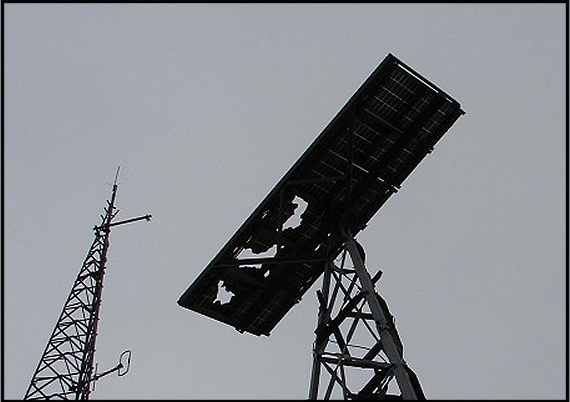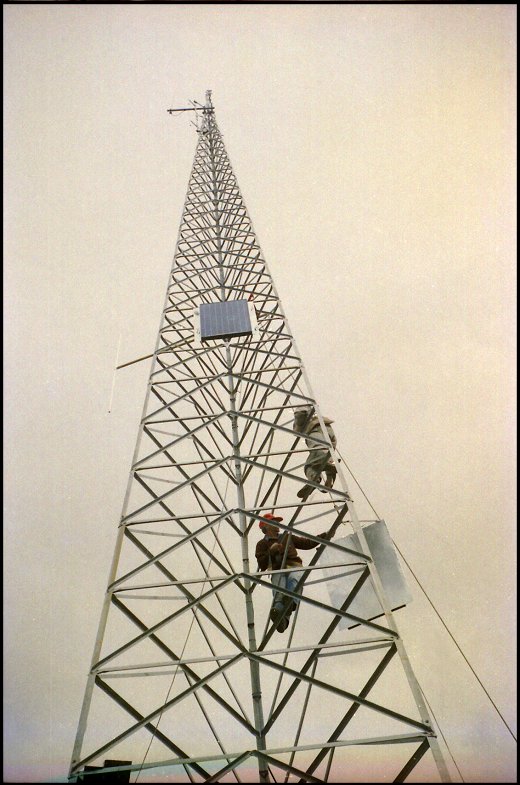VK6RTH Post Construction History
Home| Once construction was completed at Tic
Hill, the only repeater installed was the 2 metre repeater VK6RTH, on
146.200 -
146.800 MHz. This repeater had been co-sighted at Roleystone with
VK6RAP under the callsign VK6RAH. With the move to Tic Hill the
callsign was changed to VK6RTH, as the ACMA were now allowing callsigns
with a choice of the two last letters. Prior to this only the last
letter could be chosen was the last letter. All callsign before this
were VK6RA followed by your choice. This repeater was of the cut up IC22a mounted in a machined aluminium box. The basic repeater ran about 20 watts and a 80 watt PA was added. Using two 2N6084s the PA required a lot of heat sinking.  VK6RTH 2 metre repeater (IC22a) with 80 watt PA  Heat sink of 80 watt PA. The 3 coloured coaxs were all double screened Of prime concern was just how well the large wind generator would perform. There was more power available than was needed by a long way but how reliable would the wind generator be...? From memory the wind generator lasted perhaps two years before we had blade problems. The generator lost a blade. It was repaired and back in service. Fingers crossed it was just a one of. Standby 80 amp generator
As a standby, an 80 amp 12V petrol generator was installed on the concrete roof of the hut. This had to be manually started when needed but at least if there was a problem with the wind generator we had standby power. The generator could be left running and stopped once it ran out of petrol.  12 volt 80 amp standby generator at Tic Hill (no longer there) VK6RSM 6 metre repeater at Tic Hill A six metre repeater was under construction using an Icom IC60, along similar lines to the IC22a repeater. The site for this six metre repeater was Tic Hill. A six metre duplexer had to be designed and built. There was expertise on building and tuning two metre duplexers but none on six metre duplexers. Apart from knowing they were a lot bigger it was trial and error to design and build a six metre duplexer. Remember this was way before you could type in six metre duplexer on Google and get a thousand hits. However to be on the safe side, 2 six metre dipoles were constructed and installed at Tic Hill to allow the six metre repeater to operate on split antennas.  The 2 six metres dipoles for VK6RSM The first thing to do was to make 2 cavity filters that would resonate at six metres. The 2 metre cavity design WARG had used was scaled up in length, the diameter was left as 4". Would it work....?  The prototype 6 metre cavity filters. By
following the two metre cavity filter design they worked. It did take a
lot of fiddling of the L & C components to produce the
required notches, but the end result was notch depths of 70dB at the 1 MHz separation, which
proved enough for six metres.
The six metre repeater VK6RSM (six metres) was installed at Tic Hill. Note the callsign, as this was before the ACMA allowed a single callsign for a number of repeaters and links at a particular site, all for the price of one licence. The six metre repeater however suffered from power line interference due to the large power lines to the North. Even two metres had some power line interference as well and eventually the six meter repeater VK6RSM was moved to Roleystone, today operating under the callsign VK6RAP. Tic Hill goes solar
The wind generator provided more power than
the site needed but became more and more unreliable. Continued blade
problems forced the a solar array to be installed and the wind
generator was removed. In its place a large frame was installed that
housed 6 solar panels and produced in total 15 amps. This was more than
enough to power the site and ran okay until the solar panels were
damaged by rock throwing vandals. Four panels were destroyed and
possibly a 5th. With at best, only two panels working, the solar
output was reduced to less than 5 amps. Enough for the site to work
through summer but not enough through winter.
 Damaged
solar panels at VK6RTH
The problem with replacing the solar panels on the large frame was the physical difficulty of doing it. Vertical Solar Panels
Due to a generous donation from Mac VK6MM,
two large solar panels were purchased. However they sat around for many
months while the difficulty of mounting them on the wind generator
tower or the main tower was discussed.
The idea was thought of to do it the easy way and mount the panels flat against the main tower, one facing NE and the other NW. The reasoning was, at least the panels would be doing something and it was an interesting experiment to discover just how much lower would the overall output be compared to the normal facing North 30 degree elevated panel. Test were carried out on the panels in the near vertical position and it was discovered that the two panels would produce 75% as compared to the normal mounting. This was a bit of a surprise, as during the morning the NW panel would have no output, and in the afternoon the NE panel no output. However there are advantages as the NE panel received the early rising Sun up to 2 hours before the normal mounted solar panel and the same for the NW panel in the late afternoon. For about 50% of the day both panels are near full output. An added benefit was the lower cost of the mounting hardware, and the easier attaching of the panels to the tower. In fact the cost of the mounting hardware was about the same as the another same size solar panel. It was thought that more panels could be added in the same way if needed. The installation was during 1996.  Dennis (was VK6LD) now VK6DEN and Ralph VK6KRB  Lifting up the second solar panel  Dennis (was VK6LD) and Chris VK6KCH attaching the vertical solar panels This
picture above appeared on the front cover of Amateur Radio Magazine
 The
Solar Installation Crew left to right.
John VK6NT Cliff VK6LZ Ralph VK6KRB Chris VK6KCH Dennis VK6LD - VK6DEN Photographer Will VK6UU UHF Repeater for Tic Hill
A UHF repeater was installed at Tic Hill using an Icom IC-RP3010 WARG's first commercial repeater purchase. This repeater ran for a number of years before being relocated to Roleystone to replace the original UHF repeater at Roleystone. The reason why this was done I can not remember.  At
one time Tic Hill housed 3 voice repeaters on 6m 2m & 70cm
4WD Club Relay
WARG was approached by a 4WD club
that run a HF net for members to keep in touch while traveling around
Australia, often in remote locations. This is not amateur radio but a
separate licensed service. HF communications is a valuable means of
keeping in touch when way out back.
The proposal was to install a HF receiver at Tic Hill and connect this to a VHF transmitter running as a LIPD, with a transmitter power of less than 100mW. The reason for the HF to VHF relay was for 4WD members who live in Perth, who were unable to monitor HF due to noise could instead monitor the VHF channel and hopefully receive a better signal. WARG agreed and a HF dipole was strung off the main tower along with a VHF dipole. A extra solar panel was also installed to provide power for the system. The idea worked and in fact the coverage of the VHF LIPD signal running about 70mW was so good the ACMA asked for access to the site to check the transmitter power..! This was done and the power was measure at 70mW...! Packet
During the 1980s packet radio
appeared and expanded at a fast pace. A digipeater was installed at Tic
Hill and still is operational today (2010). Packet activity has
declined greatly and interest in APRS has seen APRS equipment
installed at Tic Hill with the antenna on the old wind generator tower.
|